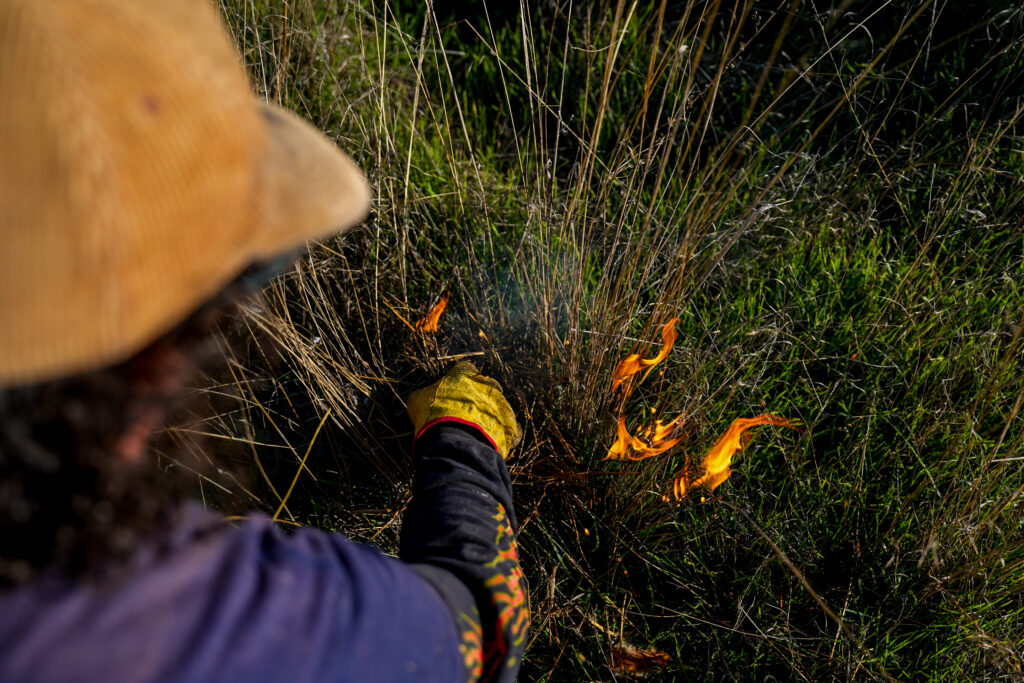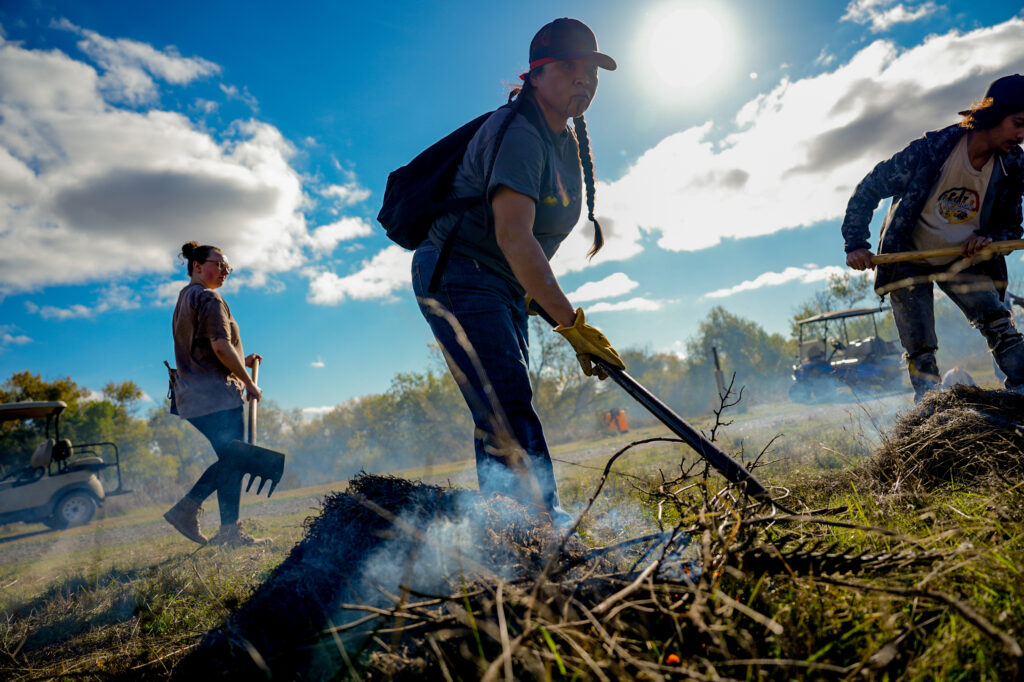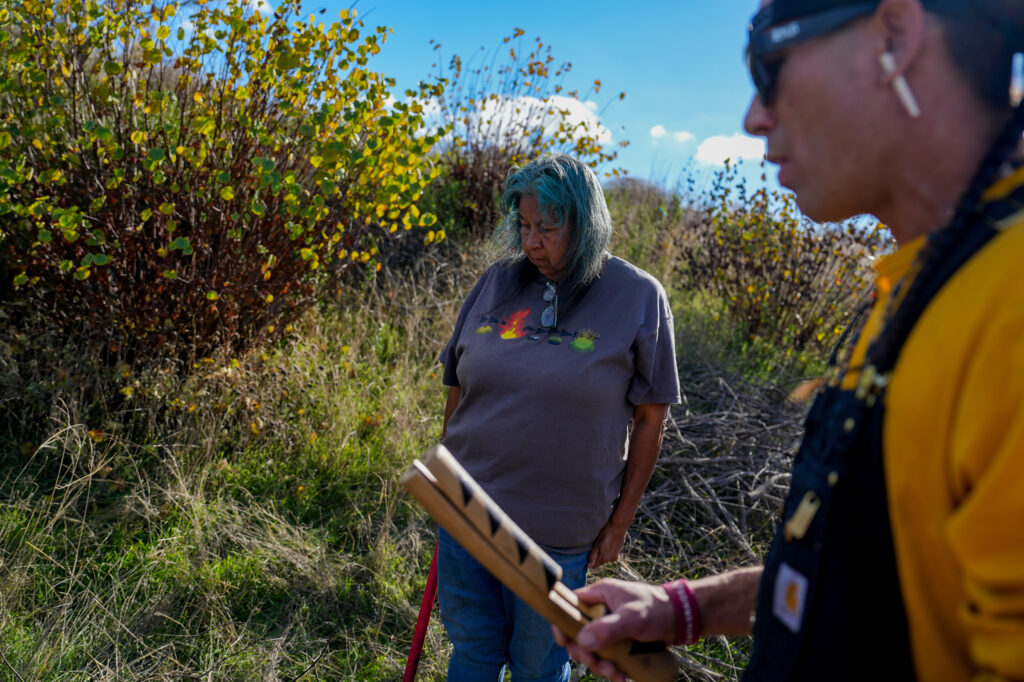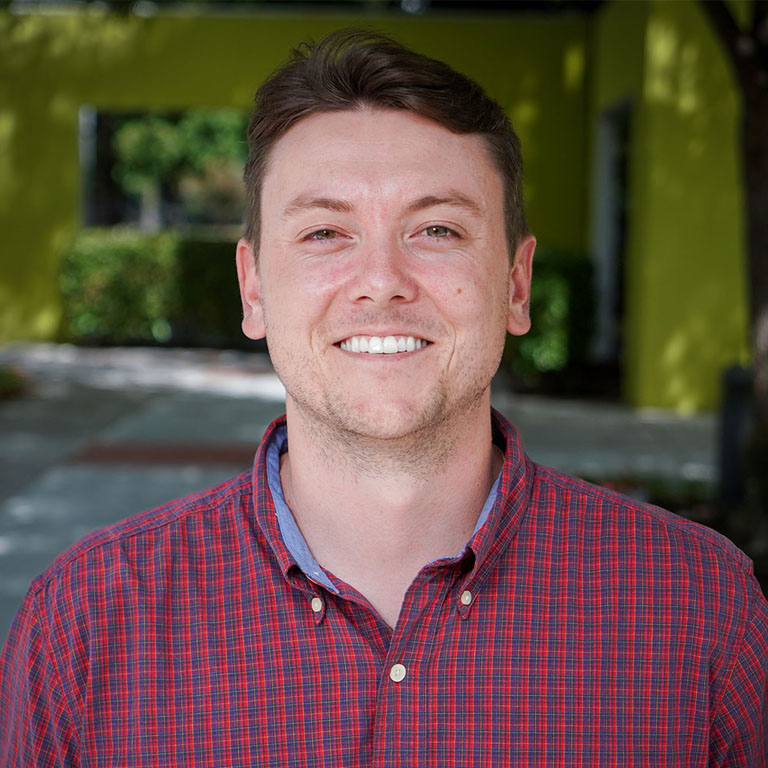The Abridged version:
- The Cache Creek Nature Preserve hosted a workshop on cultural burning last weekend.
- As California’s wildfires get increasingly intense and destructive, tribal members are sharing the benefits of Leok Po, or “good fire” in the Wintun language, for effective management of the land.
- Officials have reconsidered the state’s approach to fighting fire, emphasizing beneficial burning as an important part of fire mitigation.
Six summers ago, when the 305,000-acre Hennessey Fire crawled over the hills into the Capay Valley, it burned nearly everything in sight. The blaze, which took just under a month to contain, left behind a charred landscape with scars still visible years later.
Over the weekend, part of Yolo County caught fire again. This time, though, it looked a little different.
“Fire comes in a lot of different packages,” said Landin Noland, a UC Davis Ph.D. candidate and cultural fire practitioner, as he tended to a low-intensity fire at Cache Creek Nature Preserve on Friday in Yolo County.
As part of a three-day workshop hosted at the preserve, the cultural burn was meant to demonstrate the practice of Leok Po, or “good fire” in the Wintun language, and its importance in helping manage the California landscape. While a gathering of dozens of fire professionals, tribal members and the public carefully spread the flame, it slowly burned tall patches of grass and shrubs. When the smoke cleared, tall, flammable plant fuel had been turned to ash, but the ground beneath it remained green and cool to the touch.

Benefits to the land
This kind of cultural burning is something that tribes in California have done for millennia.
James Kinter, a former tribal secretary of the Yocha Dehe Wintun Nation, said many tribes in California started low-intensity, nondestructive fires to manage pests, control weeds and create a healthier environment for the people living there.
“It was something that was taught through the generations,” he said.
But then came settlement and inclusion of the land that now makes up California into the United States.
“The land was taken by the settlers, and when somebody else owns the land, you can’t go burn their land,” Kinter said. “So over time, it just kind of went away.”
As the practice faded, the land became unhealthier, Kinter said.
“You take away the tribal folks that are doing this practice after it becomes outlawed, you take away the elk herds and the antelope who are natural grazers, and over time you’re not able to keep up with the wild growth in California,” he said.
That wild growth became fuel for high-intensity, destructive wildfires.
“We’re seeing the land is so unhealthy now that we’re getting these fires that are just tearing through communities and whatnot, and a lot of these communities are built in areas that tribes used to burn,” Kinter said, referring to the catastrophic wildfires in the Los Angeles area earlier this year.

Buy-in from the state
In response, California has been re-evaluating how it fights fire. After years of increasingly destructive blazes wrought by climate change, population expansion and a buildup of fuel, officials have recognized that fire suppression by itself does little to solve broader land management challenges.
Len Nielson, staff chief for prescribed fire at CalFire, said his agency, the governor’s office and others have put increased emphasis on beneficial and prescribed burns as a management technique.
The policy for over a century, Nielson said, was suppression first.
“Have we suspended fire in California for the last 150 years? Yes, we have,” he said. “We’re fixing that now by recognizing the importance of cultural burning and cultural fire management as a real concept and thing that’s valuable in California.”
Along with other management agencies, Nielson and CalFire drew up a strategic plan in 2022 that focuses on expanded use of beneficial fire in statewide management efforts.
“In that plan, we really highlight how CalFire is going to work with cultural fire practitioners and the Forest Service with managed fire to get more beneficial fire on the landscape,” he said.
That has meant, in part, CalFire participation in cultural burn awareness trainings like the one at Cache Creek Nature Preserve, which was one of 13 it has provided support for statewide.

Changing mindset
Despite recent statewide legislation that was intended to diminish legal barriers to cultural burning, hurdles remain for practitioners. For one, cultural burning is different from the prescribed burning that has become standard procedure for agencies like CalFire. As California tribal communities work to reestablish what was once common practice, some in the state have had to reevaluate their own relationships with fire.
Shawn Kinney, chief of the Yocha Dehe Fire Department, said he has come to understand cultural burning as being fundamentally different from what he learned during his career as a firefighter in Davis.
“I was very much coming from a mindset of, ‘OK, I want to get so many acres done, and it’s going to protect the community in this way,’” he said. “Shawn Kinney’s way of lighting 40 acres and I’m calling that a good day because we were productive and we hit some mark is completely different than what a cultural burn is.”
Cultural burning can have objectives beyond just creating fire buffers for communities. Kinney said that when they conduct cultural burns, multiple generations of tribal members participate.
“This is an opportunity for the tribe to get together, and I’m talking not just one, but maybe two or three generations are out there,” he said.

Kinter agreed that the benefits, both to the land and its communities, go beyond just wildfire mitigation. As the tribe has expanded and sustained its cultural burning practice, the land has responded.
“Over time, we’re seeing a lot of natural plants come back, oak trees being healthier, you get a bigger crop from the acorn population on the oak trees because of the smoke on the ground,” he said. “What we’re seeing is just a healthier landscape.”
In Kinter’s eyes, expansion of cultural and beneficial burning is the way forward for a fire-choked state, and the stakes are high.
“This is only 100, 150, 200 years of us not taking care of the land properly,” he said. “We’re just trying to take care of the land, because we want to make sure the land is there for future generations to utilize.”
Daniel Hennessy joins Abridged from the California Local News Fellowship. He’s a reporter covering Yolo County.
Correction: An earlier version of this story misstated James Kinter’s role. He is a former tribal secretary of the Yocha Dehe Wintun Nation. Corrected at 8:05 a.m. on Wednesday, Nov. 12.

